Sous Vide Bags 101: How to Choose the Right Bags for Sous Vide
The ultimate guide to choosing the right sous vide bags to unlock sous vide success in your kitchen.
Sous vide, a French cooking technique that has gained popularity in recent years, involves cooking food in a temperature-controlled water bath. This method allows for precise control over the cooking process, resulting in perfectly cooked meals every time.
But why do you need the right bags for sous vide? Well, the bags used in sous vide cooking play a crucial role in ensuring the success of your meals. In this post, I will guide you through the process of choosing and using the perfect bags, so you can unlock sous vide success in your own kitchen. We will also discuss and address a big concern—plastic waste.
- Benefits of Using Sous Vide Bags: Keeping Food Fresh and Flavorful
- Understanding the Different Types of Sous Vide Bags and Their Pros and Cons
- Factors to Consider When Selecting a Sous Vide Bag
- Alternatives to Sous Vide Bags
- Conclusion
- About the Author
Benefits of Using Sous Vide Bags: Keeping Food Fresh and Flavorful
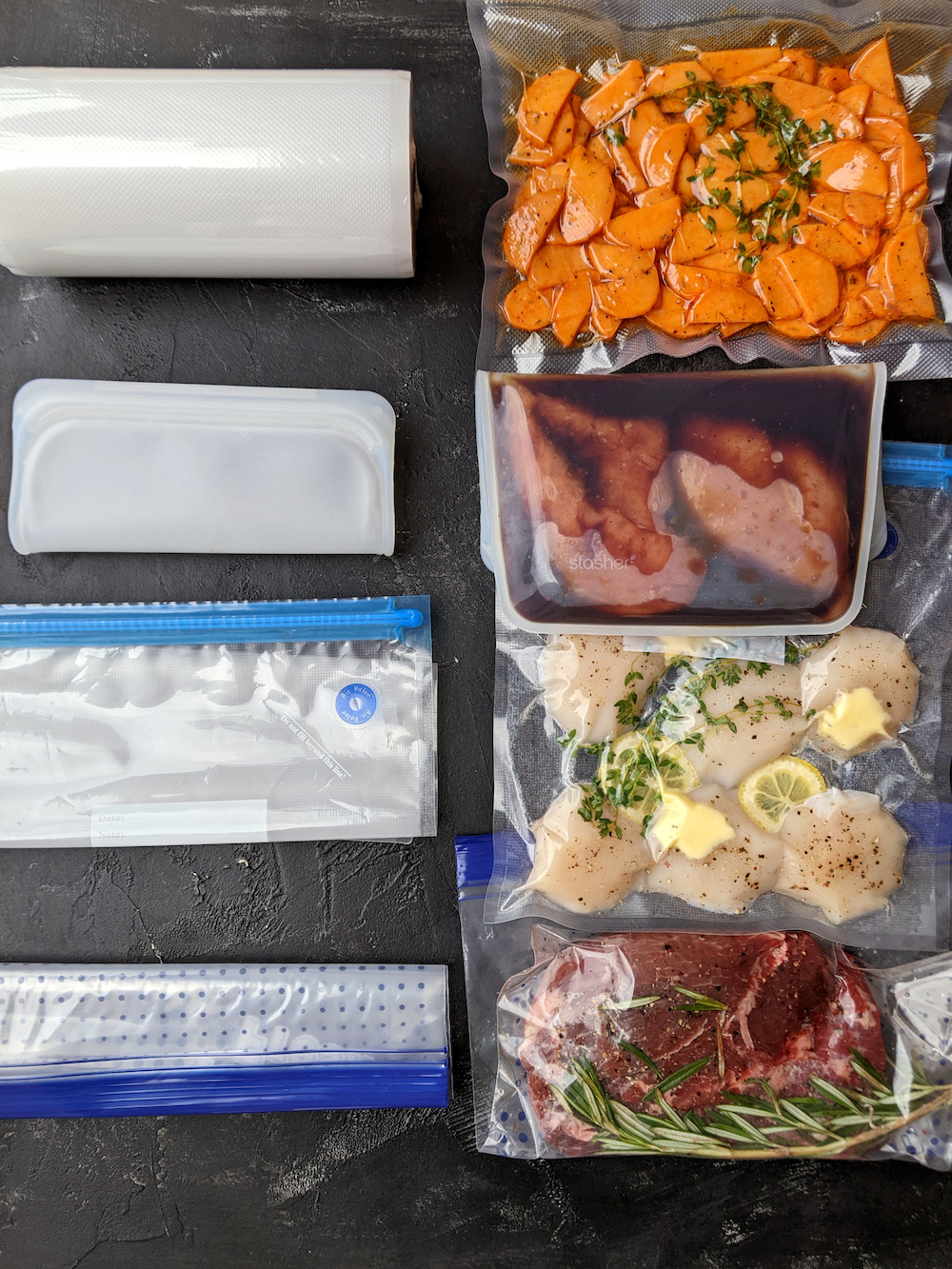
One of the key benefits of using sous vide bags is that they help keep your food fresh and flavorful. These bags are designed to provide an airtight seal, preventing any air or moisture from entering or escaping. This means that the natural flavors and juices of your ingredients are locked in, resulting in incredibly tasty and succulent meals. Additionally, the airtight seal also prevents any cross-contamination, ensuring that each ingredient retains its distinct taste and aroma. So whether you’re cooking meats, vegetables, or even desserts, sous vide bags are your secret weapon for preserving freshness and enhancing flavor.
How do you choose the right bags to sous vide then? Let’s dive in.
Understanding the Different Types of Sous Vide Bags and Their Pros and Cons
There are four main types of sous vide bags on the market. They are zip-top bags, reusable sous vide bags, silicone bags, and vacuum-sealer bags. Except for the silicone bags, the other three types are made of BPA-free and food-grade plastic. All of them are also food storage bags, and I personally use all four. Here are the pros and cons of each type along with tips on when to use them based on my personal experiences. I hope you find it helpful.
Zip-Top Bags
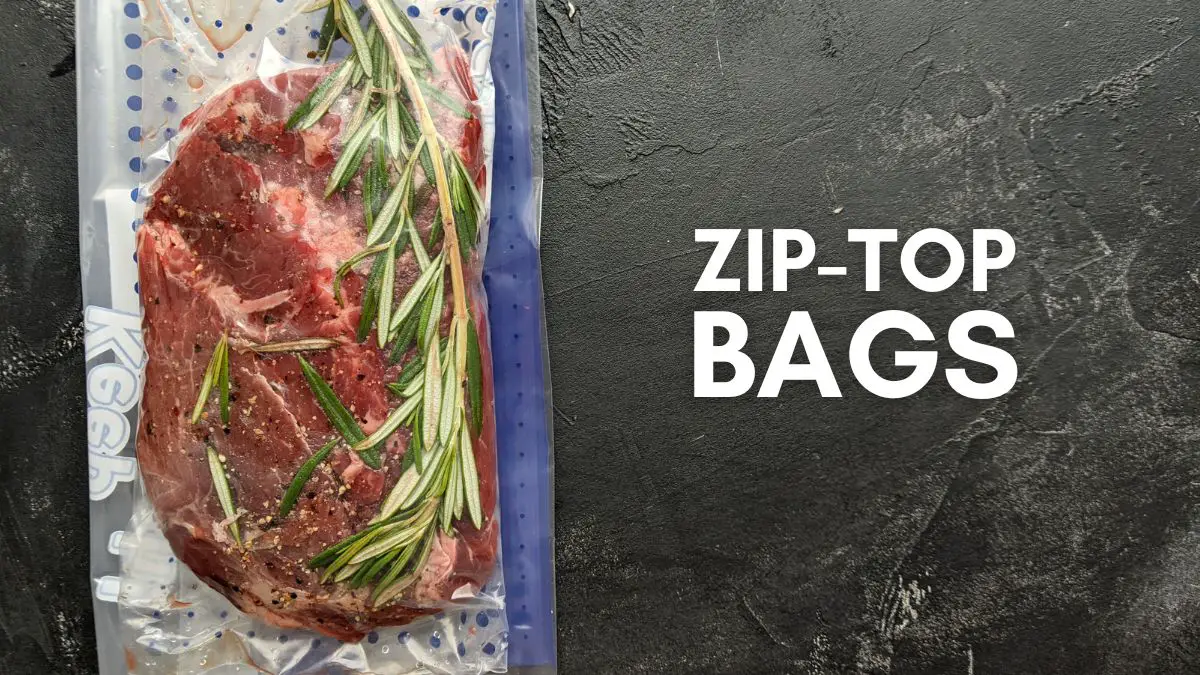
A zip-top bag is also known as zipper storage bag, slider storage bag, zipper bag, zip lock bag, or zippie. It’s made of durable food-grade plastic. Ziploc® is the most popular and familiar brand in this category. There are regular zip-top bags and freezer bags, which are slightly thicker, making them sturdier and more durable, and freezer safe.
Using zip-top bags for sous vide is super convenient, but keep in mind their limitations.
Pros
- Very accessible and the most cost-effective.
- Convenient and no cleaning is needed if you don’t want to.
- No vacuum sealer is required.
Cons
- Not suitable for high temperatures or/and long hours of cooking.
- Not ideal for cooking larger cuts and vegetables.
- Not environmentally friendly.
What Zip-Top Bags Are Good For
- Any sort of dense foods, particularly ones that come in smaller pieces, like steak, fish, pork chops, tenderloins, chicken breasts, etc. Those foods fit easily in zip-top bags of different sizes, and they are unlikely to float during the cooking process due to their high density.
- Foods that cook for a shorter amount of time (less than six hours).
- Foods that cook at temperatures below 158°F (70°C).
- Foods with a lot of liquid, like a protein with marinade or a stew.
Where Zip-Top Bags Fall Short
- When exposed to high temperatures and/or long hours of cooking, the seams of a zip-top bag sometimes fail, causing unwanted leakage. That’s why these bags are not recommended for cooking over 158°F (70°C) and/or for over six hours.
- Zip-top bags are not suitable for sous vide vegetables for precisely this reason, since vegetables usually require cooking temperatures of over 180°F (82°C). It’s also because vegetables are usually less dense, so they tend to float. You are going to have a really hard time weighing down a zip-top bag with low-density vegetables in it, as it’s impossible to get all the air out of the bag, and some vegetables make their own gas when cooking.
- While zip-top bags are recyclable, the process is difficult and inaccessible in many countries, so they often end up in the trash bin after use.
StreetSmart Tips on Using Zip-Top Bags for Sous Vide
- Apply the water displacement method. To use zip-top bags for sous vide cooking, you basically use the water from your sous vide bath to push the air out of the bag as you lower it into the water. The goal is to fully submerge the food. This is called the water displacement method. It’s fairly easy to execute. Here’s how to do it.
- Place your prepared food in a bag. Zip up 80%, leaving the corner of the bag unzipped. (Note that the food contents shouldn’t occupy over ½ of your bag. There should be enough room left at the top of the bag without getting the zip line under the water.)
- Slowly lower the bag into the sous vide water bath. The pressure of the water will force the air out of it as you progressively immerse the bag. Gently squeeze out any air surrounding the food, especially the air bubbles trapped around it.
- Once the food is fully submerged and the water level is just below the zip line, seal the bag fully and clip the top of it to the edge of your cooking vessel.
- Double bag. If you are concerned about your zip-top bag leaking during sous vide cooking, it’s always a good idea to add another bag for security. To do so, simply put your bag of food into a second bag of the same size, then use the water displacement method to submerge it. As long as the first bag that’s in contact with the food doesn’t leak, you can later reuse the second bag.
- Wash and reuse. One of the benefits of sous vide cooking is that there’s almost zero cleaning required after cooking. This is referring to using plastic bags to cook and discarding the bags afterward. It’s certainly convenient, but a personal choice could be washing the used zip-top bags that are still in good shape and reusing them for food or storage. This is not only about saving money but also about doing what you can to reduce plastic waste.
Reusable Sous Vide Bags Kit
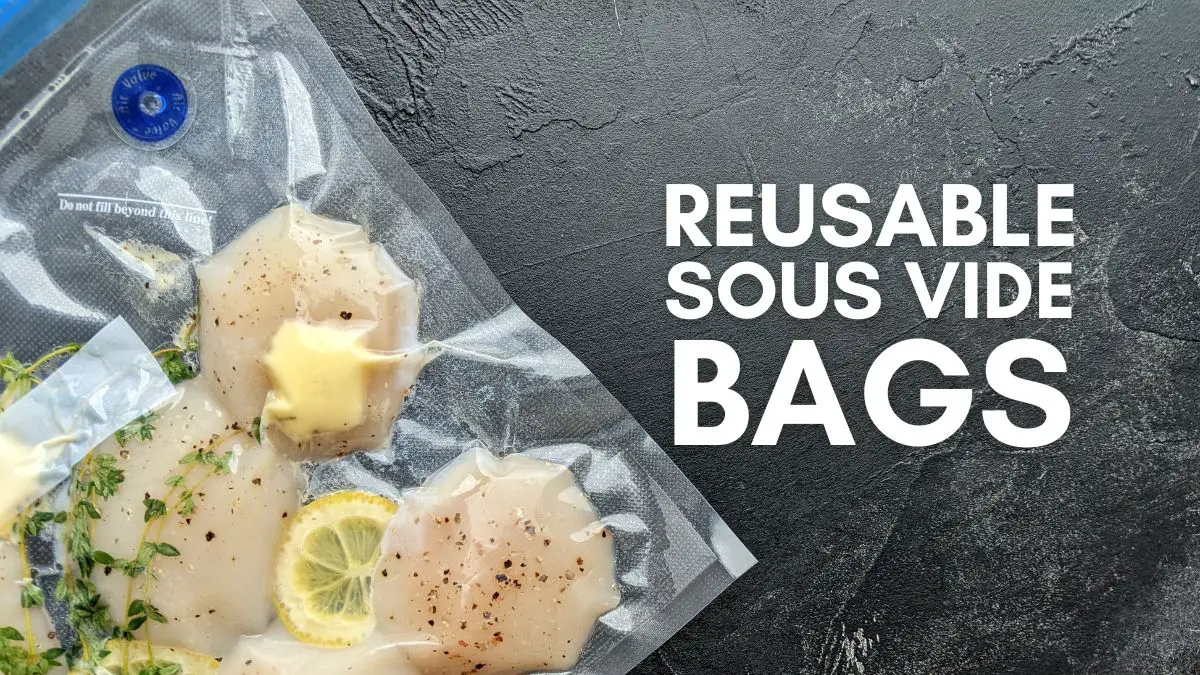
To step up your sous vide game, the reusable sous vide bags kit on Amazon is a good option because it’s thoughtfully designed for sous vide home cooks who seek the best cooking results but do not have a vacuum sealer. The kit is essentially a manual vacuum sealing system. It includes reusable plastic bags with air valves, a hand pump, and sealing clips. Before I owned a vacuum sealer, these were my go-to sous vide bags.
Pros
- Made from high-quality food-grade plastic, which is safe for cooking at higher temperatures and for long hours. They are heavy-duty and freezer safe as well.
- Achieve vacuum-seal effects with a double zipper and manual pumping without using a vacuum sealer.
- Designed for reusing and reducing plastic waste.
Cons
- Manually vacuum-sealed foods with a lot of liquid can be difficult.
- When cooking in bulk or sous vide meal prepping for a week, pumping air out manually from multiple bags can be time- and labor-intensive.
- Cleaning is required.
- The air valves can fall off if not careful during washing. In that case, the bags are not reusable for sous vide anymore.
What Reusable Sous Vide Bags Are Good For
- Cooking at a temperature that’s above 158°F (70°C) and/or for longer than six hours.
- All foods including vegetables.
- Large cuts of meat and other centerpiece dishes using a large-sized bag from your kit.
- Prepping ahead to freeze and cook later or cooking ahead to freeze and enjoy later.
Where Reusable Sous Vide Bags Fall Short
- If you want to cook with marinade or with liquid, pumping the air out of the bag through the air valve can be tricky, as the liquid can easily be sucked into the hand pump, causing a messy situation.
- If you like to make large amounts of food with single portions ahead of time, using the hand pump to manually suck the air out of multiple bags in one sitting can be quite tiring and tedious.
- The sous vide bags are designed to be washed and reused many, many times. However, the air valve cover can fall off before your bag is worn out, leaving a hole in the bag that renders it unusable.
- You’ll need to remember to keep the hand pump and the sealing clips handy, as these items are essential to using the bags for sous vide cooking. This means more stuff to keep around.
- The bags do come in large sizes, but they might still not be big enough for certain foods, say a whole turkey.
StreetSmart Tips on Using Reusable Sous Vide Bags
- Keep the double zipper clean. Fold the top of the bag outward over itself to form a hem. This will prevent any seasonings or food juice from interfering with the seal.
- Leave the air valve area alone. When adding food to the bag, avoid contacting the air valve, as any liquid or food bits can interfere with the vacuum-sealing process during pumping.
- Wash with caution. As mentioned earlier, the air valve cover can easily fall off if you are not careful. Avoid scrubbing that area for the longevity of the bags.
Silicone Sous Vide Bags
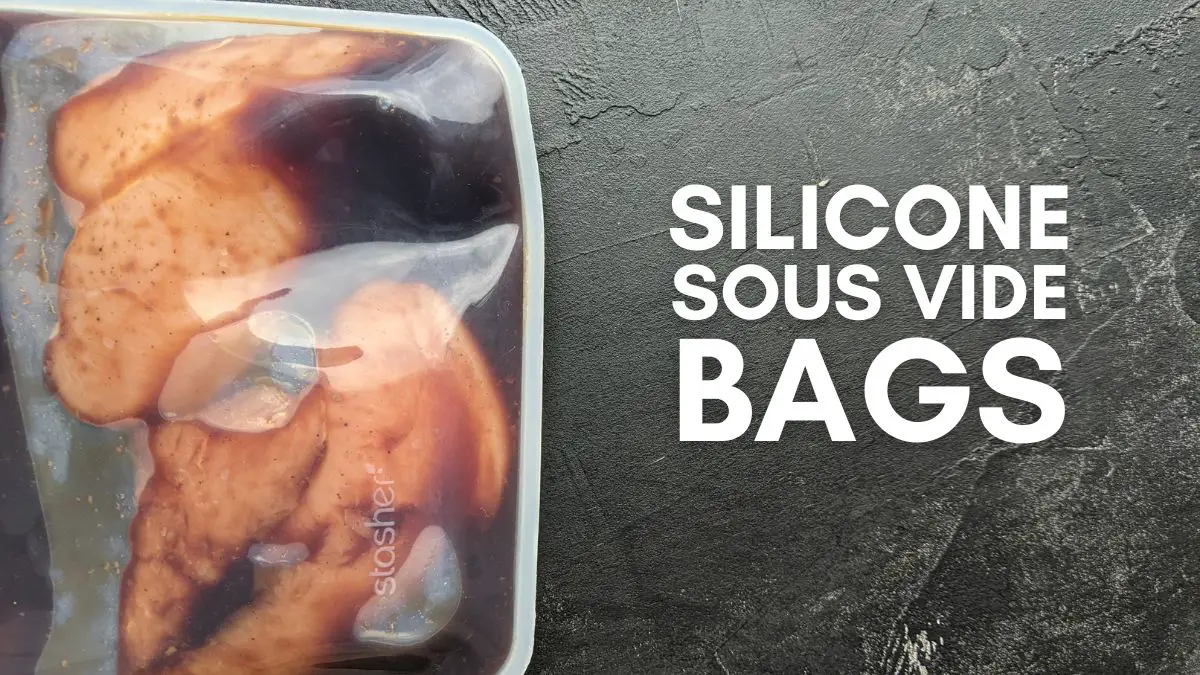
The best-known sous vide bags made of silicone are Stasher bags. These multiple-purpose storage bags are microwave-safe, dishwasher-safe, oven-safe, and of course, sous vide-safe. They can be reused thousands of times for the years to come if you take care of them properly, making them the most environmentally friendly option for sous vide.
Pros
- Made with platinum food-grade silicone and a leakproof Pinch-Loc seal, they’re free from lead, latex, BPA, and any other materials with names that you’ve never heard of.
- Endlessly reusable and resealable, doing no harm to our Earth.
Cons
- Very pricey.
- It’s in their user manual that you should not fold the top of the bags. This makes it tricky to get food inside without touching the seal.
- Limited options on size.
What Silicone Sous Vide Bags Are Good For
- Cooking small cuts like chicken breasts, steak, pork chops, lamb chops, fish filets, etc. for one or two people.
- Cooking foods with marinade or sauce.
- Foods that require long hours of sous vide cooking.
Where Silicone Sous Vide Bags Fall Short
- Because it’s not recommended to fold the top of the bag, I personally find that stuff can easily get in the seal while placing food inside the bag, especially if you use a dry rub. If seasonings and/or food bits get stuck inside the seal, you will need to wipe it clean before sealing.
- There are limitations on the amount of food you can sous vide with silicone bags due to their relatively small size.
- You’ll still use the water displacement method to submerge your foods. You may find it tricky to force the air out entirely, especially where it’s close to the top, so the bag might float. For the same reason, it’s not ideal to use silicone bags to sous vide vegetables.
StreetSmart Tips on Using Silicone Sous Vide Bags
- Use them for small portions of food. Portion the food first, holding the bag open as wide as possible, and carefully placing the food inside the bag. This can help avoid the food from touching the bag seal.
- Use them for marinating. It’s easier to get the unseasoned piece of food inside the bag, then pour a marinade over it. You can later directly drop the bag into a sous vide bath to cook.
Vacuum Sealer Bags
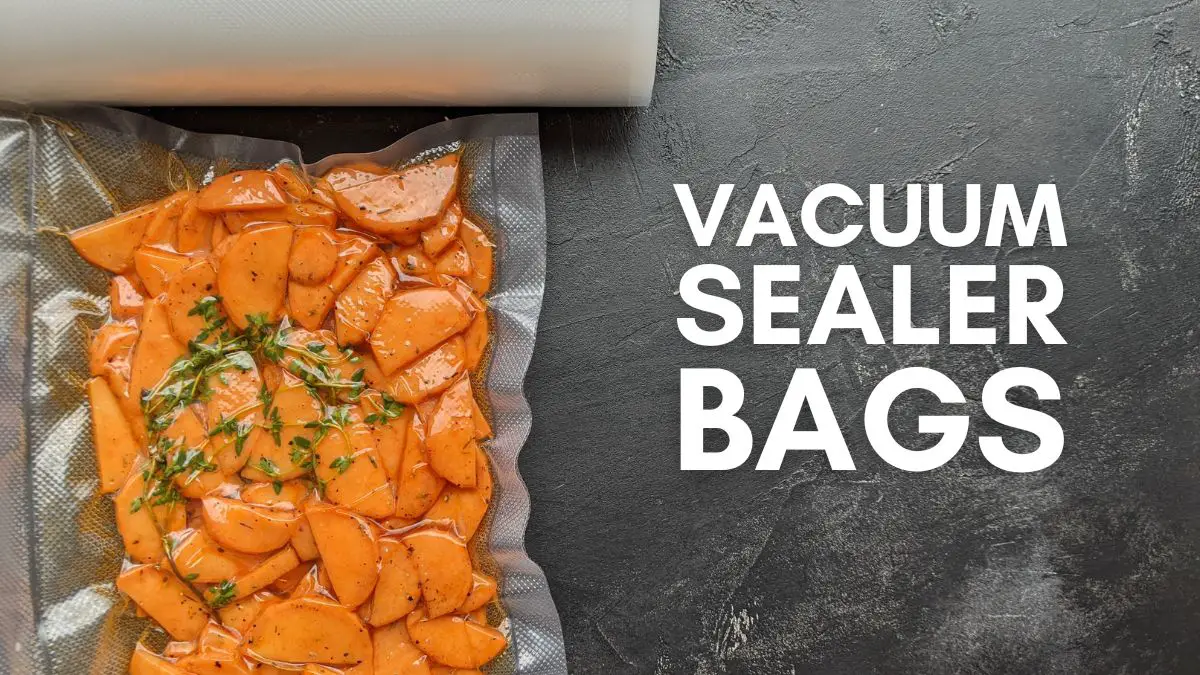
Vacuum-sealer bags are made specifically for vacuum sealers. So let’s briefly look at the two types of vacuum sealers—suction vacuum sealers and chamber vacuum sealers—as the bags for them are different.
Suction vacuum sealers suck the air out of a bag. They use embossed/textured vacuum-sealer bags, with one smooth side and one textured.
Chamber vacuum sealers don’t suck. Instead, they pump all of the air (including the air inside the bag) out of the chamber at once, giving your item a truly airtight seal. It’s recommended to use chamber vacuum pouches, which are made with less plastic, so they are much more cost-effective.
You can use regular/suction vacuum-sealer bags in a chamber vacuum sealer, but the chamber vacuum-sealer pouches are not effective in a suction vacuum sealer.
While it’s probably true that chamber vacuum sealers allow you to save money on the cost of chamber pouches compared to suction vacuum sealers in the long run, chamber vacuum sealers are much more expensive and are bigger in size.
At the moment, I use an Anova suction vacuum sealer paired with pre-cut vacuum-sealer bags and vacuum sealer rolls. FoodSaver is another vacuum sealer often recommended by the sous vide community.
Pros
- Effortless sealing with a vacuum sealer creates the best result for sous vide cooking.
- Vacuum seal rolls can be custom-cut into your desired size. This reduces the amount of plastic you use and saves money.
- Great for sous vide meal prep, as vacuum-sealed foods preserve the quality and freshness much longer in the fridge and freezer.
- Can be used to sous vide pretty much anything.
- No cleaning is required.
Cons
- A vacuum sealer is required.
- Not environmentally friendly.
What Vacuum Sealer Bags Are Good For
- Sous vide cooking everything of all sizes, including vegetables.
- Keeping food fresh five times longer.
- Storing leftovers, marinades, sauces, and more.
- Weekly meal prep or make-ahead meals. For example, you can season your food as you bag it up, then seal it and leave it in the freezer. When ready to cook, no thawing is required—just throw it in a sous vide bath. In my Sous Vide Once, Savor All Week meal prep program, we vacuum seal foods to cook, then store them in the same bag to enjoy throughout the week.
Where Vacuum Sealer Bags Fall Short
- You’ll need to invest in a vacuum sealer. (Although the total cost of a sealer and bags may seem higher than a stack of zip-top bags or reusable sous vide bags, it’s well worth it for the benefits it brings.)
- Like zip-top and reusable sous vide bags, vacuum sealer bags are recyclable. If that’s an option for you in your area, please utilize it. However, recycling these plastic bags is not yet accessible in many parts of the world.
StreetSmart Tips on Using Vacuum-Sealer Bags
- Make the sealer bags do double or triple duty. Use the same sealer bags for freezing, sous vide cooking and food storage. In an article titled “Earth Day Thoughts – Minimizing Waste and Plastic Use with a Vacuum Sealing System,” my favorite vacuum-sealer bag brand Avid Armor says, “Yes, you’re still using plastic, but you made those bags do double-duty, effectively halving the amount of plastic you used.”
- Wash and reuse. Just like reusable sous vide bags, it is easy to clean and reuse your vacuum sealer bags for sous vide cooking. If you are careful about how you open and clean your bags, you can get at least three or more cooking uses out of each vacuum sealer bag. Here is how to do it. When you open a sealed vacuum bag, be sure to cut the bag open as close to the seal as possible, empty the contents, and wash it thoroughly with hot water and dish soap. Once you have washed the bag out, make sure to prop it open to air-dry before reusing it. Note that as you reuse the bags, they will get smaller each time. This will significantly cut down the amount of plastic you use for sous vide and will save money.
Factors to Consider When Selecting a Sous Vide Bag
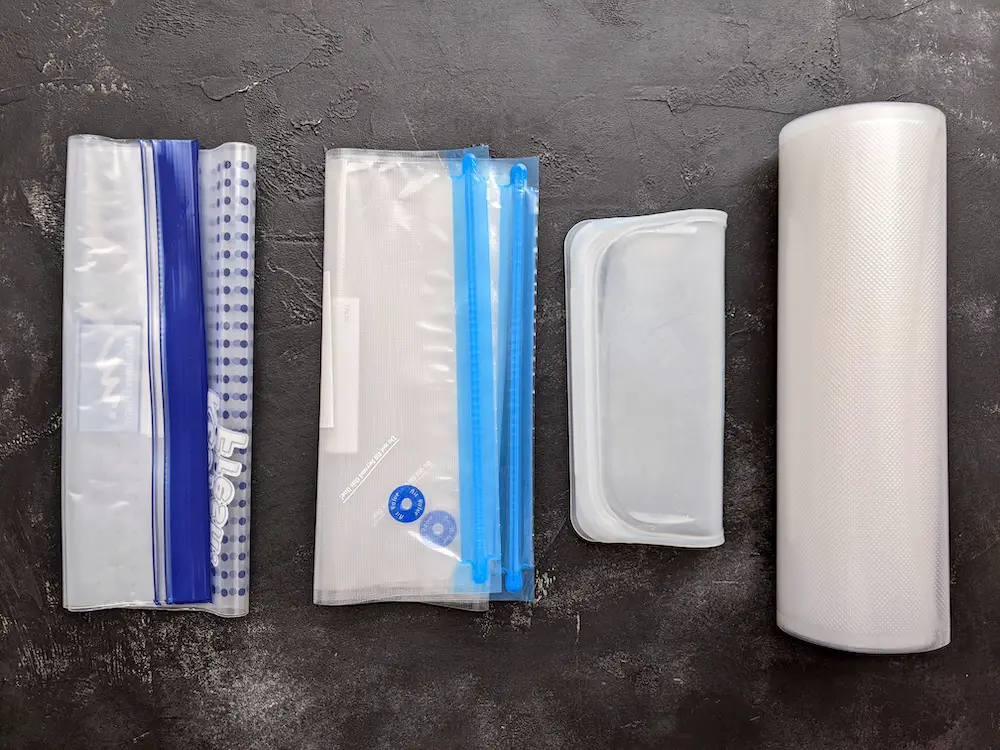
Whether you are a beginner or a seasoned sous vider, knowing the in and outs of each type of sous vide bag can help you make the right choice every time you set up your sous vide machine. To do so, consider the following factors before choosing a bag.
- Cooking time and temperature. Will you be cooking for longer than six hours? Will you be cooking at a temperature that’s higher than 158°F (70°C)? If so, consider not using zip-top bags.
- Wet or dry. Does your food have a lot of liquid (marinade, sauces, etc.)? If so, consider silicone sous vide bags or zip-top bags if not cooking at a high temperature for a long period of time.
- Large or small cuts of protein. You want to choose bags that are large enough to hold your ingredients comfortably, but not too large that they take up unnecessary space in the water bath. It’s best to have a variety of sizes on hand to accommodate different recipes. For large cuts, consider vacuum-sealer rolls, as you can custom-cut them to fit your needs. For smaller cuts, zip-top or silicone bags can do.
- Vegetables. If you are cooking vegetables, the best choice is a vacuum sealer with vacuum sealer bags.
- Meal prepping. In a vacuum-sealed bag, sous vide cooking pasteurizes vegetables and meat, so you can store the sous vide food in the fridge for a whole week or freeze them for months or years at a time without freezer burn.
- Environment. Are you mindful of plastic use? If so, consider using environmentally friendly bags like silicone sous vide bags if possible. Wash and reuse plastic bags whenever you can.
StreetSmart Tip for Sous Vide Beginners: If you’re just starting out, and you’re reluctant to invest in reusable bags or a vacuum sealer, that’s totally fine! You don’t need to. Start by cooking with Ziploc bags that you probably have in your kitchen already. If you’re cooking at temps over 158°F (70°C) or for longer than six hours, double-bag your food. If and when the time is right, you can explore the reusable and vacuum-sealing choices. For a detailed and in-depth breakdown, check out and download my Complete Guide to Sous Vide Cooking.
Alternatives to Sous Vide Bags
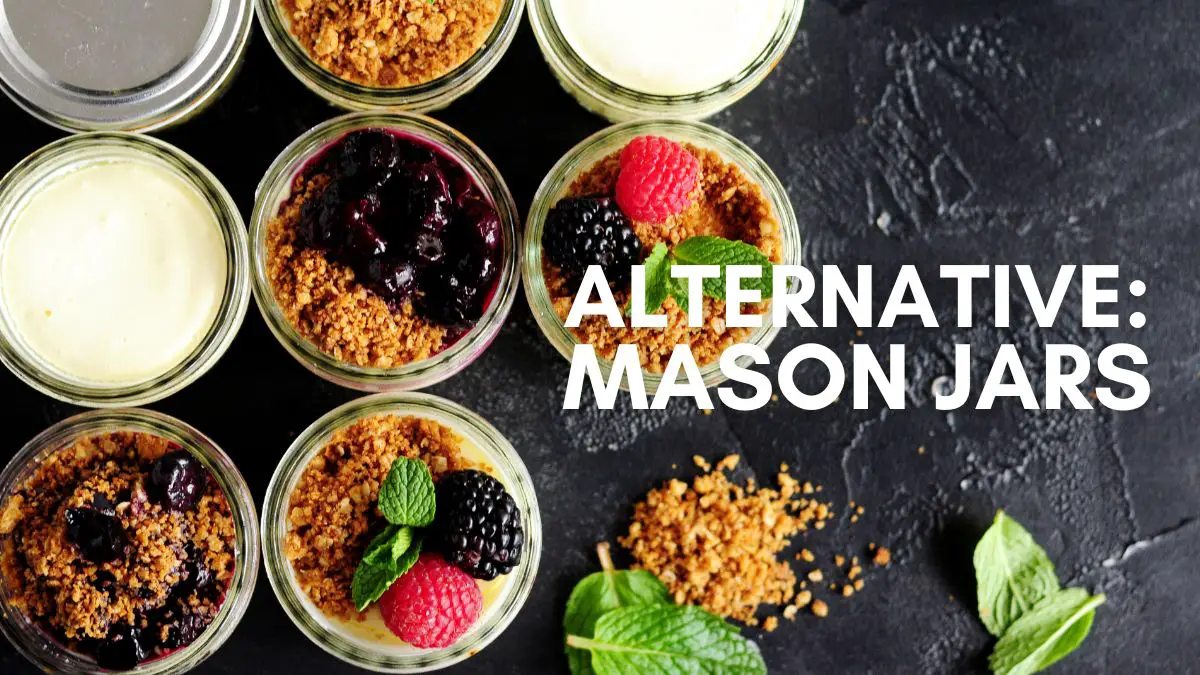
Mason jars seem to be the only alternative at the moment, and they are a great one! It’s unrealistic to use Mason jars for sous vide meats and fish, etc., but they’re wonderful for sous vide cheesecake and sous vide yogurt. Other items that you can sous vide in a Mason jar include lemon curd, chocolate pudding, crème brûlée, grains and beans, confit, and paté.
Conclusion
When choosing the type of sous vide bag, consider your specific needs and preferences. Whether you opt for zip-top bags, reusable sous vide bags, silicone bags, or vacuum-sealed bags, each option offers its own benefits. Experiment with different types to find the one that suits your cooking style and produces the best results. With the right sous vide bags, you can take your culinary skills to the next level and impress your family and friends with consistently delicious meals.
Which type of sous vide bags are your go-to cooking bags and why? Leave a comment below and let all of us StreetSmart Sous Viders know.
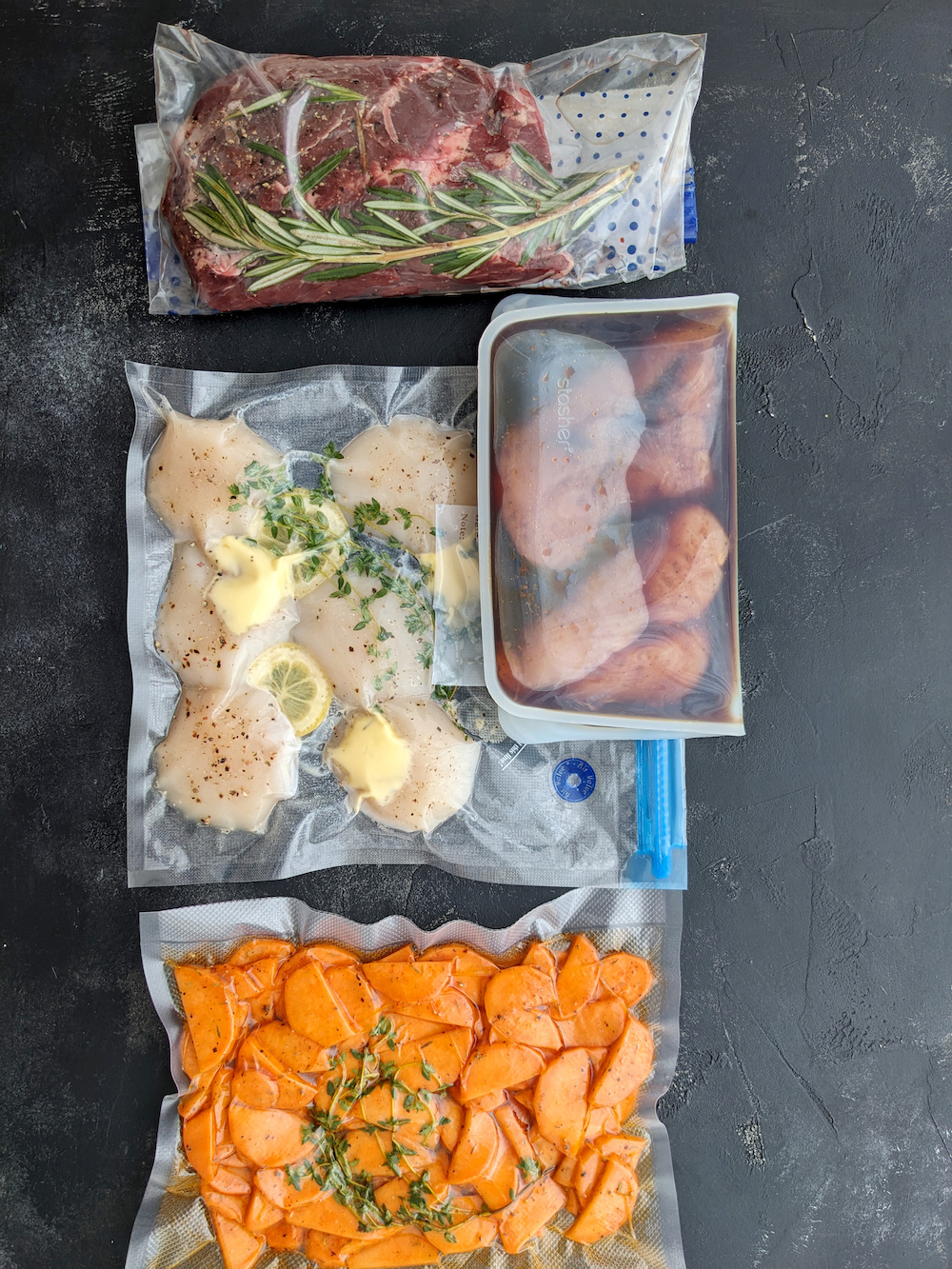
About the Author
Sharon Chen is an Integrative Nutrition Health Coach and author of the Complete Sous Vide Cookbook. She believes food not only brings healing but also connection. As the creator of StreetSmart Kitchen, she aims to make meal prep easier than ever and help you find balance, ease, joy, and simplicity in the kitchen as you improve your well-being.



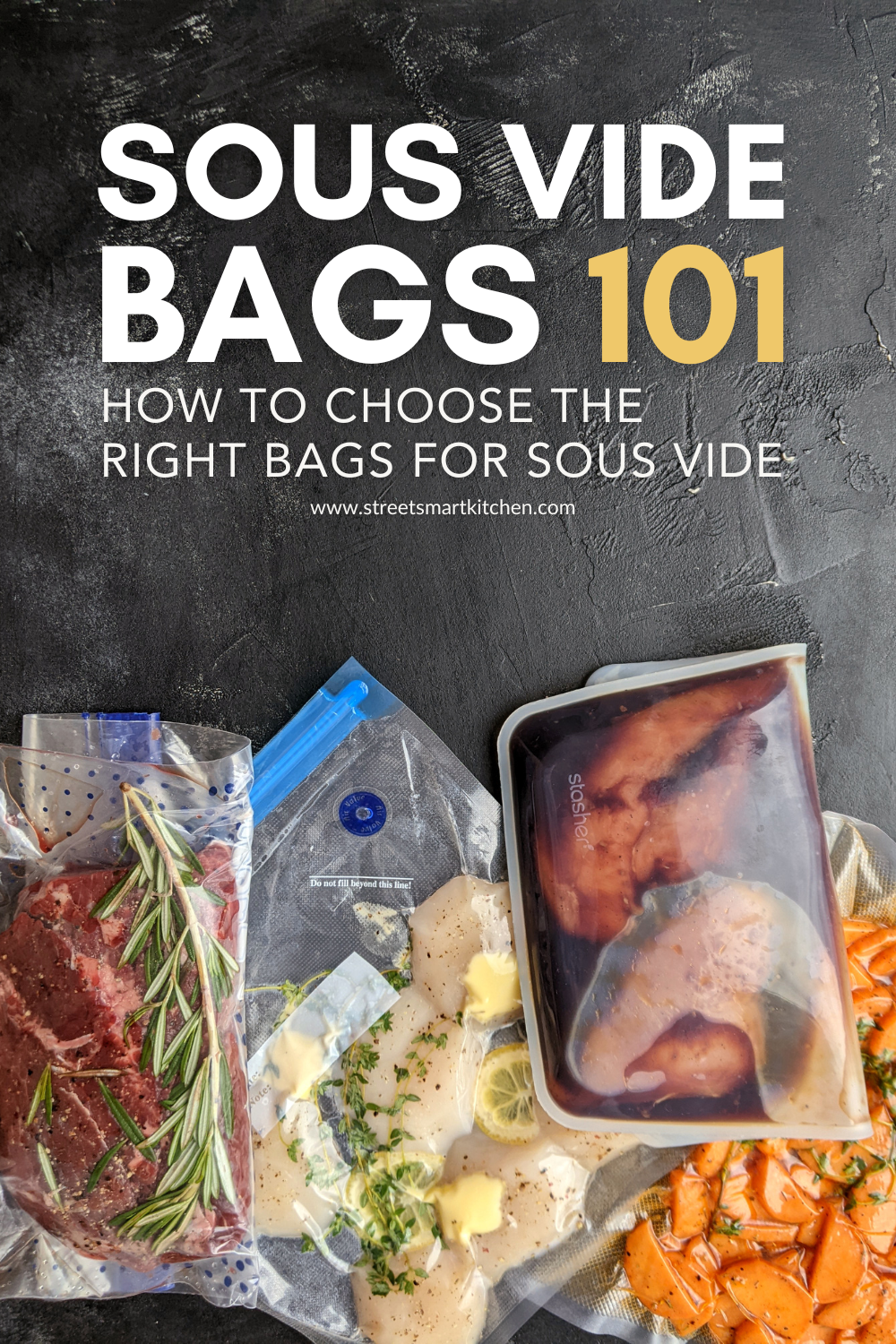
Pingback: Silicone Bags: An Eco-Friendly Alternative to Vacuum Sealing
This was excellent information for a newbie sous vider. I was quite aware of all the different types but it was interesting to get a reminder.
The question that you didn’t answer was are the bags good for the environment? Unfortunately they don’t seem to be able to be composted, although ANOVA has made an attempt with their bags.
I love sous vide but even although I try to reuse, the plastic does end up in the garbage.
As fate would have it… I was cooking sous vide corned silverside yesterday in a zip-lock bag. The bag split but the final result was still delicious. This morning I received your ‘bag choice’ blog! I think I will stick to using my vacuum sealer in future. Thank you Sharon for all the great recipes, advice and tips you share, it is certainly appreciated.
I am a novice sous vider and found this post to be extremely helpful! So many tips and tricks; looking forward to giving some recipes a try, indeed!
What a great breakdown of Sous Vide bags! We have several different types but I always go to my favorite vacuum-sealed ones because of ease of use. Will check out these other types.
Such a great guide. I just got into sous vide so this is perfect!
This was such a helpful guide to figuring out the right bags for sous vide! Bookmarking this and will definitely be coming back to this the next time I sous vide at home!